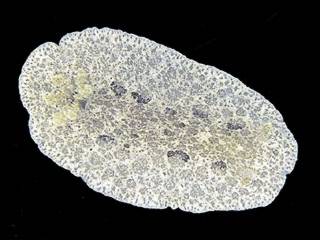
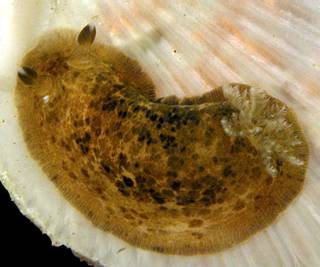
Discodoris evelinae
Marcus, 1955
Order: NUDIBRANCHIA
Suborder: DORIDINA
Superfamily: EUDORIDOIDEA
Family: Dorididae
DISTRIBUTION
Brazil to Florida
PHOTO
St. Ann's Bay, Jamaica, West Indies. Photo: R. Gundersen.
Reference:
• Marcus, E.V. (1955). Opisthobranchia from Brazil. Boletim da Faculdade de Filosofia, Ciencias e Letres. Universidade de Sao Paulo, Zoologia, 20: 89-261
Rudman, W.B., 2001 (June 12) Discodoris evelinae Marcus, 1955. [In] Sea Slug Forum. Australian Museum, Sydney. Available from http://www.seaslugforum.net/find/discevel
Related messages
Discodoris evelinae from live rock shipment?
April 22, 2008
From: Brian K. Penney
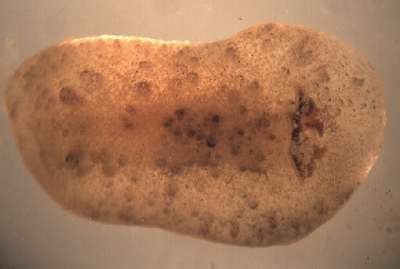
I have a cryptobranch dorid that suddenly appeared on the wall of my sump tank, right where the water input gives the best flow. I had received a live rock shipment about a month before, and my guess is that this individual ran out of its prey sponge and surfaced to lay eggs.
I have included a photo of the dorsal side. The mantle is covered with low papillae (like Geitodoris heathi I have seen) and spiculate, with some spicules protruding slightly from the papillae but not formed into caryophyllidia.The individual is about 12 mm long, oral tentacles are finger-like and has a distinct mouth, the anterior foot margin is bilabiate and notched. Unfortunately, the slug would not cooperate for a photo of the ventral side, so the quality of this photo is a bit poor!
The live rock was from a lease in Key West (from tampabaysaltwater.com), but the supplier gives no more detailed location information. The only Carribean fauna manual I have available to me is the Humann & DeLoach Reef Creature 2nd edition, and Discodoris evelinae is the best match given that source. However, this individual seems much smaller than the sizes listed on the Slug Forum.
The slug also laid an egg mass straddling the water line in the position of highest water flow: just slightly longer than one complete, counterclockwise spiral, slightly ovoid and 13 mm in the longest direction (horizontal), and approximately 10 mm in the vertical. It is cream/light yellow colored. Unfortunately, I cannot get a good picture, as it is in a very awkward place in the sump!
Any help confirming identification is appreciated!
Locality: Live rock shipment from Tampabaysaltwater.com, unknown, Florida, USA, Atlantic Ocean, Gulf of Mexico, 17 September 2007, Coral rubble. Length: 12mm. Photographer: B.K. Penney.
Brian K. Penney
bpenney@anselm.edu
Penney, B.K., 2008 (Apr 22) Discodoris evelinae from live rock shipment?. [Message in] Sea Slug Forum. Australian Museum, Sydney. Available from http://www.seaslugforum.net/find/20822Dear Brian,
It's quite likely it's a juvenile Discodoris evelinae. Perhaps one of our colleagues with a knowledge of the Caribbean animals alive can help.
Best wishes,
Bill Rudman
Re: Information about Discodoris evelinae
March 27, 2006
From: Andrej Jaklin
Concerning message #16131:
Dear Bill,
If I didn't know where the animal on Discodoris evelinae Fact sheet (lower photo) is from, I would without much thinking say it's Dendrodoris grandiflora from the Adriatic Sea!
I would like to hear opinion from other colleagues from the Mediterranean on this.
Best regards,
aj
jaklin@cim.irb.hr
Jaklin, A., 2006 (Mar 27) Re: Information about Discodoris evelinae. [Message in] Sea Slug Forum. Australian Museum, Sydney. Available from http://www.seaslugforum.net/find/16168Dear Andrej,
That photo came from a message from Ross Gundersen [#11112] and as I commented there, his description of it breaking off its mantle skirt made me think of Discodoris. I also thought I could see papillae all over the mantle which would be most unlike Dendrodoris. However on reflection perhaps his upper photo is a Dendrodoris. Angel Valdes [message #5289] said that D. krebsii was the only species of Dendrodoris like this in the west Atlantic, but the striations around the mantle edge certainly look like D. grandiflora.
I am puzzled by Ross's mention of mantle autotomy, I have a feeling some Dendrodoris break off part of their mantle during preservation but I can't find a reference. This animal certainly looks like a Discodoris in colour, so if it is really a Dendrodoris, perhaps Ross confused the two. Like you, I would welcome some comments from Angel and other experts on the Atlantic fauna.
Best wishes,
Bill Rudman
Information about Discodoris evelinae
March 25, 2006
From: Rolando Cortés Vico
I have an specimen that is the same as a picture you show named Discodoris evelinae. I tried to link with that name in the list of species but it didn't work. Can you send me information, and more pictures about it? It is in synonymy with Cadlina evelinae Marcus, 1958, Family Cadlinidae that is reported to Cuba?
Locality: Coast, 1 m, W of Havana City, Cuba, Caribbean
I took pictures but they are not good, that is the reason for not sending it here.Thanks in advance for your help
Truly yours
Rolando
rolandoc@acuarionacioanl.cu
Cortés-Vico R. M.Sc., 2006 (Mar 25) Information about Discodoris evelinae. [Message in] Sea Slug Forum. Australian Museum, Sydney. Available from http://www.seaslugforum.net/find/16131Dear Rolando,
We have been having a few problems with the Forum but they are now solved so you should be able to get to the Discodoris evelinae Fact Sheet now. Cadlina evelinae is now known as Tyrinna evelinae. As you will see it is quite a different species. If you would like to send your photos to the Forum that would be welcome - there is no rule saying they have to be perfect.
Concerning species called 'evelinae'. There are quite a few western Atlantic species with that name. Ernst and Eveline Marcus, who worked at the University of Sao Paulo, Brazil, studied the opisthobranch fauna of your region for many years, and Ernst named many species after Eveline, who was both his wife and collaborator.
Best wishes,
Bill Rudman
Discodoris evelinae with egg mass in Brazil
September 21, 2005
From: Vinicius Padula
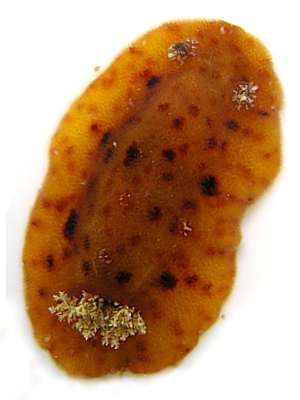
Dear Bill,
I send this photo of a common species in the north litoral of Rio de Janeiro state - Discodoris evelinae.
Locality: Cabo Frio, Rio de Janeiro, Brazil, Atlantic Ocean. Depth: 1 meter. Length: 30 mm. September 2005. Intertidal. Photographer: V.Padula
Best Regards,
V. Padula
viniciuspadula@yahoo.com
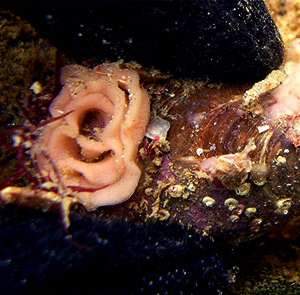
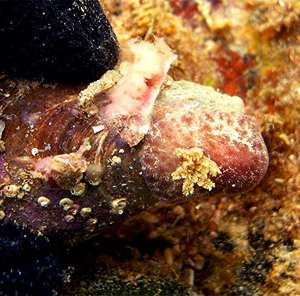
Dear Padula,
This is a valuable addition to the Forum. We now have a number of rather different looking animals on the Forum identified as Discodoris evelinae. I am afraid the original description of this species doesn't give me enough information on the external colour to know which is likely to be D. evelinae and which are not. It would be good to see photos of all the 'flat' dorids from your part of the Brazilian coastline so we could try and match them up with the species described by the Marcuses. Some no doubt would be quite easy to identify from their internal anatomy, but it might not be so easy to identify just from photos.
Best wishes,
Bill Rudman
Discodoris evelinae from Jamaica
October 9, 2003
From: Ross W. Gundersen

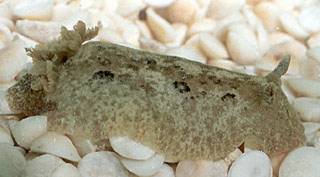
Dear Bill:
Here is another sea slug from Jamaica. As I said in my first message, all specimens were collected from St. Ann's Bay, Jamaica, West Indies. Photo: R. Gundersen.
Here is Discodoris evelinae. Found under a rock in Thallassia bed at 2 m depth.
Identified by description from Marcus of Jamaican material. Upper image is a lighter coloured juvenile. Juveniles still have the two characteristic rows of irregular dark spots.
Best wishes,
Ross
ross.gundersen@uwp.edu
Gundersen, R.W., 2003 (Oct 9) Discodoris evelinae from Jamaica. [Message in] Sea Slug Forum. Australian Museum, Sydney. Available from http://www.seaslugforum.net/find/11113
Thanks Ross,
I have also added the photo from your message about Dendrodoris krebsii, where you mention this species' habit of breaking off pieces of its mantle edge when disturbed.
As i say there, Discodoris evelinae may well be the same as the Indo-West Pacific species Discodoris lilacina which is well-known for his habit of breaking off the mantle skirt when disturbed. One of the other names for that species is Discodoris fragilis in recognition of this behaviour. [See autotomy Page.]
Best wishes
Bill Rudman
Discodoris evelinae, pretty in pink?
June 15, 2001
From: Elianny Domínguez Tejo
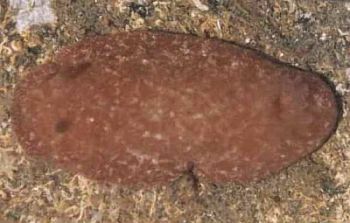
Dear Bill,
This nudibranch is 8 cm long. We found it in a rocky shore (under a rock) at a depth of 25 cm, in the Gaira Bay (Caribbean coast of Colombia). It´s light pink, with little white dots on the dorsal. The rhinophores are dark pink almost red, while the branchial crown is light pink (on the posterior end of the animal).
To me it looks just like Discodoris evelinae which is brown, but in pink color. Can you help me out? I'm confused between Discodoris and Dendrodoris???
Cheers,
Elianny Domínguez.
elicelotte@latinmail.com
Domínguez Tejo, E., 2001 (Jun 15) Discodoris evelinae, pretty in pink?. [Message in] Sea Slug Forum. Australian Museum, Sydney. Available from http://www.seaslugforum.net/find/4522Dear Elianny,
This certainly looks like a Discodoris and my guess would be D. evelinae but the lack of published photos and information on the live animals of this fauna is a major problem in identification. Another possibilty is Discodoris pusae Marcus, 1955 which Thompson (1980) describes as having a pinkish tinge in smaller animals. Unfortunately both species look very similar externally, the main point of difference being the presence of long conical hooks on the penis of D. evelinae and the lack of hooks in D. pusae. One important contribution you could make is building up information on the colour variation you find in the common species you come across. There is always a chance you will mix a couple of species together but we all have that problem to begin with wherever we work. What you will need to do is keep good colour notes on all the live specimens you collect, making sure you note even the ordinary features because in a year or two you might find an anatomical difference in what you thought were one species and then you will need to hunt back to find how they differ externally.
Concerning the difference between Discodoris and Dendrodoris. I guess you mean external differences. Species of Dendrodoris are usually much softer to touch than the relatively rough skin of species of Discodoris. Also the head of Discodoris is a distinct structure with a pair of oral tentacles while in species of Dendrodoris it is very reduced and the oral tentacles become channelled ridges on each side of the mouth rather than free tentacles.
• Thompson, T.E. Jamaican Opisthobranch Molluscs II. Journal of Molluscan Studies, 46: 74-99.
Good Luck,
Bill Rudman.
